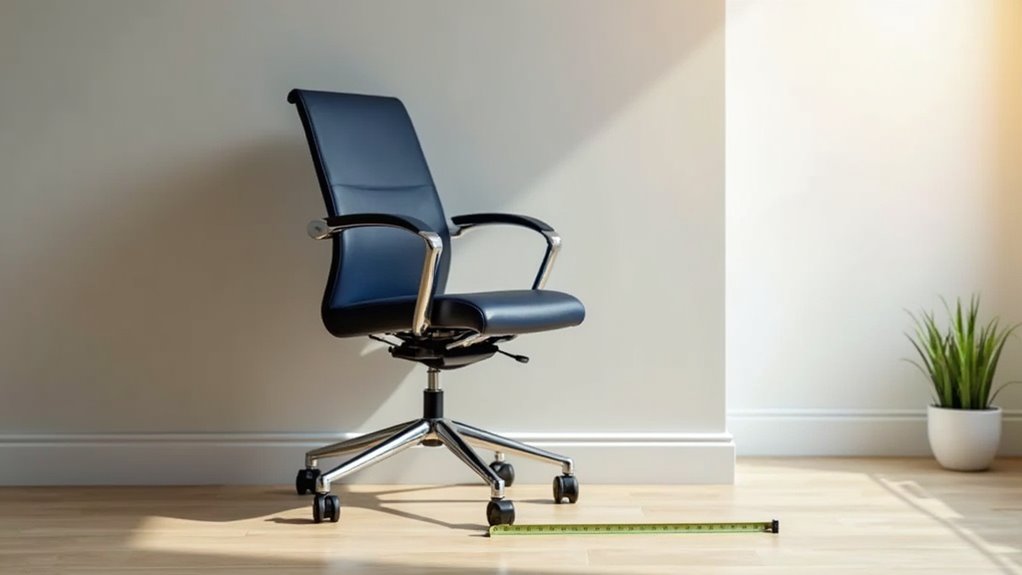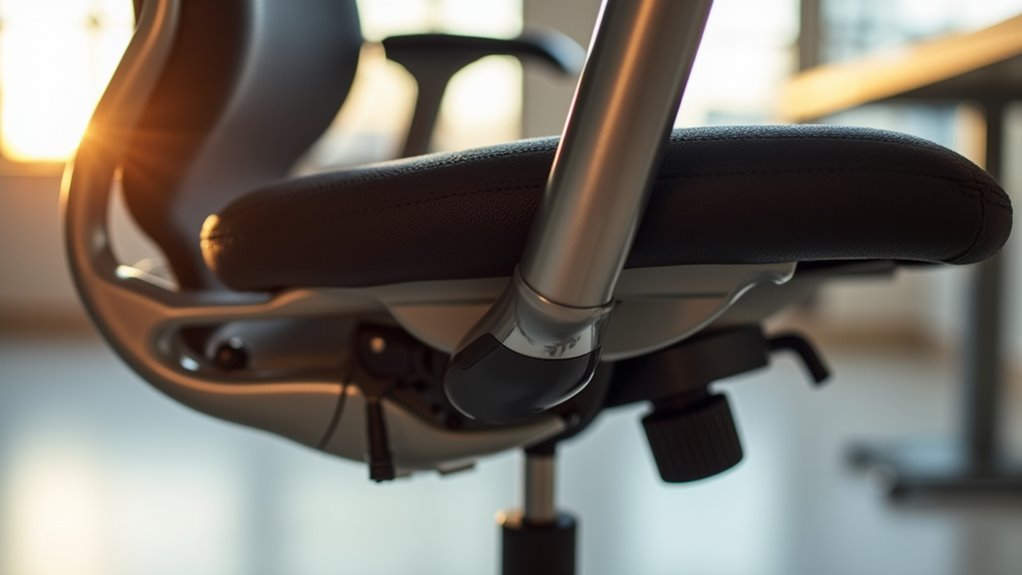How to Adjust a Chair Height With a Lever
This post contains affiliate links. As an Amazon Associate, we earn from qualifying purchases.
To adjust your chair height with a lever, locate the lever beneath the seat. To raise the chair, stand up and pull the lever up; your chair will elevate. For lowering, simply sit down, pull the lever, and allow your weight to push the chair down. Ensure your thighs are parallel to the floor for optimal comfort. Additional tips and detailed guidance will follow for those seeking to enhance their chair experience even further.
Essential Facts in 30 Seconds
- Locate the height adjustment lever under the chair.
- To raise the chair, lift off the seat and pull the lever up.
- To lower the chair, stay seated and pull the lever down.
- Keep thighs parallel to the floor for better posture.
- Ensure the lever locks securely after adjustments for stability.
Understanding the Lever Mechanism
Adjusting your chair height is easy with the lever mechanism. This lever usually works with a pneumatic system. This system helps your chair move up and down smoothly. Pulling up or pushing down on the lever opens a valve in the gas lift cylinder. This action lets you change the chair’s height. Your feet should rest flat on the floor. This keeps your legs at a comfortable 90-degree angle. Maintaining this position is crucial for proper circulation during extended periods of sitting. Additionally, ensuring your chair height is set correctly can prevent pressure on thighs which aids in overall comfort. A well-functioning height adjustment mechanism is essential for optimal chair performance.
The lever is located under the seat’s edge. It’s easy to reach without standing up. Use gentle force when you pull or push the lever. You don’t want to break anything. A light tug is all you need. The 4-lever mechanism offers more options for adjusting your chair to ensure optimal comfort and support.
Enjoy sitting comfortably in your perfectly adjusted chair! It’s like giving your chair a little hug!
Step-by-Step Chair Height Adjustment Process

Adjusting your chair height is easy and quick! Start by locating the height adjustment lever. It’s often found under the front or right side of the chair. Look for a symbol that shows an up/down arrow. Once you find it, pull the lever.
To raise the chair, lift your weight off the seat while pulling up on the lever. To lower the chair, stay seated, pull up the lever, and let your weight push it down.
Make sure your thighs are parallel to the floor for good posture. This helps avoid leg cramps and promotes proper height for enhanced comfort. After adjusting, check that your feet rest flat on the floor. Your elbows should also form right angles when at your desk. A swivel mechanism allows for simple seat height adjustments to ensure comfort, which is crucial for maintaining good posture during extended sitting. Additionally, a well-fitted chair helps prevent strain on back and other discomforts.
Finally, ensure that the lever locks into place. You’re on your way to making your chair a comfy throne!
Common Chair Lever Types and Their Functions
Don’t forget the back height adjustment knob! This knob helps you find the right height for better back support. The seat slider lever lets you move your seat closer or farther from the backrest. This is great for different leg lengths. Additionally, understanding the ideal knee angle can help you determine the best seat position for comfort. The armrest height adjustment lever raises or lowers your armrests. This helps reduce shoulder strain, while proper armrest positioning supports wrists while typing. These levers can greatly improve your comfort! Additionally, using the pneumatic lift lever allows you to easily adjust the seat height for optimal ergonomic posture. Remember, maintaining proper height not only aids blood circulation but also enhances overall comfort during long work hours.
Maintenance and Troubleshooting of Chair Height Lever

Your chair is ready with handy levers. Keeping them clean and working well is important. Start with some simple maintenance.
Check for dust or debris around the lever and hydraulic pump. Clear any blockages you find. Make sure the lever moves smoothly. If it feels sticky, use a little light machine oil. A well-maintained chair can help prevent issues related to gas cylinder function.
Troubleshooting can help if your chair won’t raise or lower. First, check for anything blocking the lever’s connection to the gas cylinder. A gentle wiggle while pressing the lever can free a stuck mechanism.
Also, confirm you meet the weight limits. Being too light or heavy can cause problems. Check the alignment and clips if the lever feels loose. Addressing issues like sinking office chairs can help maintain proper functionality.
Regular cleaning and maintenance can prevent a sinking seat. Keep your chair in good shape!
Ergonomic Benefits of Proper Chair Height Adjustment
Proper chair height adjustment makes a big difference for comfort and focus while working or studying. A sore back isn’t fun.
Adjusting your chair helps prevent muscle pain. It keeps your shoulders and elbows relaxed. When your feet are flat on the floor, circulation improves in your legs. This means less tiredness. Proper ergonomics can significantly enhance your overall well-being while seated. Additionally, ensuring that your knees are at a 90-degree angle promotes better alignment of your hips and spine.
Sitting with your hips and knees at about 90 degrees supports your spine. It reduces slouching. You’ll feel better and stay focused on your tasks. Additionally, having proper back support ensures that your spine maintains its natural alignment, further enhancing your comfort.
No one wants to sit at the edge of their seat. Adjust your chair today. Get ready to do great on your homework or project!
Frequently Asked Questions
Can I Adjust Chair Height Without Using the Lever?
You can adjust your chair height without using the lever. Try some simple methods. One way is to add or remove cushions. This can help raise or lower your seating position easily.
Another option is to check if your chair has a manual adjustment feature. Some chairs allow for height changes by turning a knob or adjusting screws. These adjustments can help you find a comfortable height.
Consider using a footrest if your feet do not reach the ground. This can improve comfort and support your posture.
Explore these options to find what works best for you. Enjoy a better seating experience!
Is It Safe to Adjust Height While Sitting?
Adjusting your chair height while you sit is not safe. Making changes before you sit is better. This way, your chair stays stable. Good posture helps you feel comfortable. Avoiding changes while sitting reduces the risk of injury. For the best ergonomic benefits, set your chair height first. Remember, a good setup can help your back and neck. Stay safe and comfortable while working or studying.
How Often Should I Check My Chair’s Height Adjustment?
Check your chair’s height every month. This helps keep your chair comfortable and supportive. Regular checks can prevent problems. A good chair height improves posture. It also reduces discomfort during long sitting sessions. Adjustments make a big difference in how you feel. Stay comfortable and focused while you work or relax. Don’t forget to check!
What Tools Do I Need for Height Lever Maintenance?
Many office workers face discomfort due to the wrong chair height. Proper chair height is important for comfort and health. To keep the height lever working well, gather some tools. You will need screwdrivers and pliers. Replacement parts are also essential. These tools help ensure your height lever operates smoothly. Regular maintenance can prevent problems down the road. Take care of your chair, and it will take care of you.
Can Height Adjustment Mechanisms Wear Out Over Time?
Height adjustment mechanisms can wear out over time. Frequent use and lack of care cause this wear. To make them last longer, keep up with regular maintenance. Lubricate the moving parts to keep them smooth. Check for any loose screws or components often. This simple care can help prevent problems. A little effort goes a long way in keeping your height adjustment mechanism working well.
Conclusion
Adjusting your chair height is simple and important. A good chair fit helps you stay comfortable. It’s like wearing the right shoes. Too tight hurts your feet. Too loose makes you unsteady.
To adjust your chair, find the lever under the seat. Pull it up or down. This changes the height. Sit down to check if it feels right. Your feet should be flat on the ground. Your knees should be at a 90-degree angle.
Check your chair height often. Changes in posture can happen throughout the day. A well-adjusted chair supports your back and keeps you focused. Enjoy your comfort. Your body will feel better for it!
